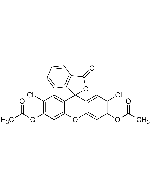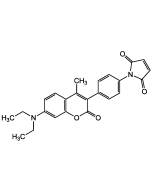Cookie Policy: This site uses cookies to improve your experience. You can find out more about our use of cookies in our Privacy Policy. By continuing to browse this site you agree to our use of cookies.
Chemodex
DAN

| Product Details | |
|---|---|
| Synonyms | 2,3-Diaminonaphthalene |
| Product Type | Chemical |
| Properties | |
| Formula | C10H10N2 |
| MW | 158.2 |
| CAS | 771-97-1 |
| Source/Host Chemicals | Synthetic. |
| Purity Chemicals | ≥98% (HPLC) |
| Appearance | Off-white to light brown solid. |
| Solubility | Soluble in DMSO, DMF or pyridine. |
| Identity | Determined by 1H-NMR. |
| Declaration | Manufactured by Chemodex. |
| Other Product Data |
Click here for Original Manufacturer Product Datasheet |
| InChi Key | XTBLDMQMUSHDEN-UHFFFAOYSA-N |
| Smiles | NC1=CC2=CC=CC=C2C=C1N |
| Shipping and Handling | |
| Shipping | AMBIENT |
| Short Term Storage | +4°C |
| Long Term Storage | +4°C |
| Handling Advice | Protect from light and moisture. |
| Use/Stability | Stable for at least 2 years after receipt when stored at +4°C. |
| Documents | |
| MSDS |
 Download PDF Download PDF |
| Product Specification Sheet | |
| Datasheet |
 Download PDF Download PDF |
The 2,3-diaminonaphthalene (DAN) assay is routinely used in the determination of nitrite/nitrate levels in biological fluids and cellular extracts as one indicator of nitric oxide activity. The assay, as reported by Misko, uses the reaction of DAN with NO2- under acidic conditions to form a detectable fluorescent naphthotriazole. The reaction proceeds at acidic pH at room temperature. Fluorescence is monitored following the addition of NaOH, which raises pH, resulting in lower background and increased sensitivity (Ex/Em: ~365/415nm). However, detection at 450nm is recommended to avoid fluorescent blanks and increase sensitivity. The fluorescent background of DAN is low for maximum sensitivity. Detection limits of NO achieved by this method are in the high-pM range. 2,3-Diaminonaphtaline (DAN) is used as a derivatisation-reagent for the determination of selenium at low detection limits. The 4,5-benzopiaselenol-complex can be quantified by photometry or GC.
(1) J. Pedro et al.; Anal. Chim. Acta 516(1-2), 229 (2004) | (2) T. Nagano et al.; Biol. Pharm. Bull. 21(12), 1247 (1998) | (3) W.C. Hawkes et al.; Anal. Biochem. 241(2), 206 (1996) | (4) R.F. Bayfield et al.; Anal. Biochem. 144(2), 569 (1995) | (5) P. Damiani et al.; Talanta 33(8), 649 (1986)












